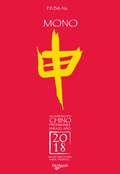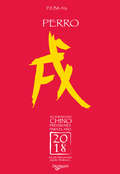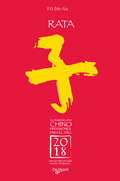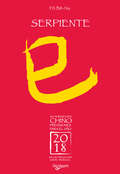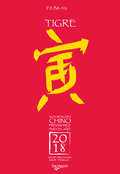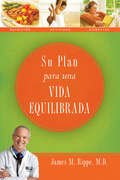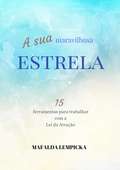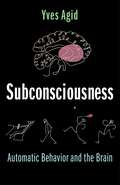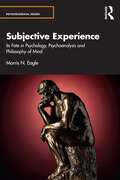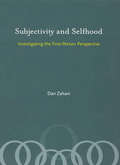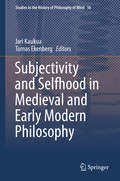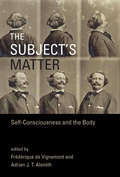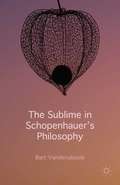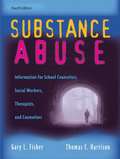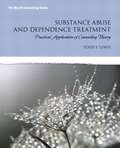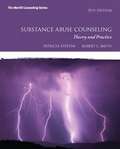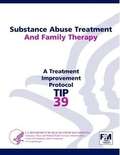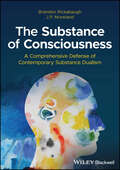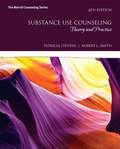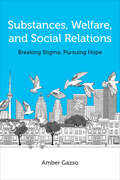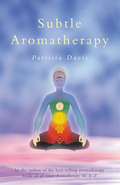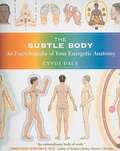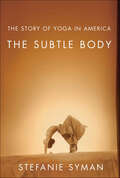- Table View
- List View
Su horóscopo chino. Mono
by Pô Bit-NaBuda convocó a los representantes del reino animal para otorgarles una recompensa; sin embargo, sólo se presentaron ante el Maestro doce especies: Rata, Búfalo, Tigre, Liebre, Dragón, Caballo, Serpiente, Cabra, Mono, Gallo, Perro y Cerdo. Buda les mostró su reconocimiento dedicándoles a cada una un año que llevaría su nombre. Conozca su signo en el horóscopo chino: la psicología, la salud, la vida sentimental, familiar y profesional, y las previsiones para el año 2018.
Su horóscopo chino. Perro
by Pô Bit-NaBuda convocó a los representantes del reino animal para otorgarles una recompensa; sin embargo, sólo se presentaron ante el Maestro doce especies: Rata, Búfalo, Tigre, Liebre, Dragón, Caballo, Serpiente, Cabra, Mono, Gallo, Perro y Cerdo. Buda les mostró su reconocimiento dedicándoles a cada una un año que llevaría su nombre. Conozca su signo en el horóscopo chino: la psicología, la salud, la vida sentimental, familiar y profesional, y las previsiones para el año 2018.
Su horóscopo chino. Rata
by Pô Bit-NaBuda convocó a los representantes del reino animal para otorgarles una recompensa; sin embargo, sólo se presentaron ante el Maestro doce especies: Rata, Búfalo, Tigre, Liebre, Dragón, Caballo, Serpiente, Cabra, Mono, Gallo, Perro y Cerdo. Buda les mostró su reconocimiento dedicándoles a cada una un año que llevaría su nombre. Conozca su signo en el horóscopo chino: la psicología, la salud, la vida sentimental, familiar y profesional, y las previsiones para el año 2018.
Su horóscopo chino. Serpiente
by Pô Bit-NaBuda convocó a los representantes del reino animal para otorgarles una recompensa; sin embargo, sólo se presentaron ante el Maestro doce especies: Rata, Búfalo, Tigre, Liebre, Dragón, Caballo, Serpiente, Cabra, Mono, Gallo, Perro y Cerdo. Buda les mostró su reconocimiento dedicándoles a cada una un año que llevaría su nombre. Conozca su signo en el horóscopo chino: la psicología, la salud, la vida sentimental, familiar y profesional, y las previsiones para el año 2018.
Su horóscopo chino. Tigre
by Pô Bit-NaBuda convocó a los representantes del reino animal para otorgarles una recompensa; sin embargo, sólo se presentaron ante el Maestro doce especies: Rata, Búfalo, Tigre, Liebre, Dragón, Caballo, Serpiente, Cabra, Mono, Gallo, Perro y Cerdo. Buda les mostró su reconocimiento dedicándoles a cada una un año que llevaría su nombre. Conozca su signo en el horóscopo chino: la psicología, la salud, la vida sentimental, familiar y profesional, y las previsiones para el año 2018.
Su plan para una vida equilibrada
by James RippeSu plan para una vida equilibrada provee estrategias del mundo real que lo preparan para alcanzar la vida con la que la mayoría sólo sueña.La mayoría de la gente trabaja demasiado, come la comida equivocada, duerme muy poco y no hace ejercicio. Está subida de peso, cansada y desbalanceada. El doctor Rippe entiende los desafíos de la vida diaria y ofrece estrategias prácticas en Su plan para una vida equilibrada que permite que cada persona comience a tomar decisiones sencillas y cotidianas que darán como resultado una vida de equilibrio sano. Creado por el cardiólogo y especialista en medicina orientada a cambiar el estilo de vida, el doctor James Rippe, el Índice de Vida Equilibrada es una prueba verificada científicamente para medir su éxito a base de tres componentes principales: Nutrición, Actividad y Bienestar. Evalúa dónde usted está y muestra dónde puede estar.
A Sua Maravilhosa Estrela
by Mafalda Lempicka Sandrina Ribeiro SousaConhece os fundamentos e o funcionamento da Lei da Atração, mas os seus resultados são irregulares ou não termina por aplicar a Lei como gostaria. Talvez esteja a falhar o seu método? Existe alguma forma mais eficaz para manifestar o que deseja? Existem várias ferramentas para atrair com êxito o que desejamos que forme parte da nossa vida. Neste livro, apresento-lhe todas as ferramentas que fui recolhendo ao longo de muitos anos de estudo e prática sobre a Lei da Atração. Assim como não há duas pessoas iguais também não existe um só método com o qual toda a gente se sente cómodo ao trabalhar com a lei da atração. Descubra as práticas mais afins a si, aquelas que lhe permitirão focalizar a sua energia criativa e lançá-la adequadamente para que o universo responda. Com este libro alcançará de uma vez por todas os seus objetivos, atrairá sem nenhuma dificuldade todas as bondades e as coisas maravilhosas que o universo tem guardadas para si.
Subconsciousness: Automatic Behavior and the Brain
by Yves AgidWe are conscious of only a small fraction of our lives. Because the brain constantly receives an enormous quantity of information, we need to be able to do things without thinking about them—to act in “autopilot” mode. Automatic behaviors—the vast majority of our activities—occur without our conscious awareness, or subconsciously. Yet the physiological basis of subconsciousness remains poorly understood, despite its vast importance for physical and mental health.The neurodegenerative disease expert Yves Agid offers a groundbreaking and accessible account of subconsciousness and its significance. He pinpoints the basal ganglia—the ancient “basement of the brain”—as the main physiological hub of the subconscious. Agid examines its roles in the control and production of automatic behavior, including motor, intellectual, and emotional processes. He highlights the consequences for various brain pathologies, showing how malfunctions of the subconscious have clinical repercussions including not only abnormal involuntary movements, as seen in Parkinson’s disease, but also psychiatric disorders such as obsessive-compulsive disorders and depression. Based on this understanding, Agid considers how seeing the basal ganglia as a therapeutic target can aid development of potential new treatments for neurological and psychiatric disorders.Shedding new light on the physiological bases of our behavior and mental states, this book provides an innovative exploration of the complexities of the mind, with implications ranging from clinical applications to philosophy’s thorniest problems.
Subjective Experience: Its Fate in Psychology, Psychoanalysis and Philosophy of Mind (Psychological Issues)
by Morris N. EagleMorris N. Eagle explores the understanding and role of subjective experience in the disciplines of psychology, psychoanalysis, and philosophy of mind.Elaborating how different understandings of subjective experience give rise to very different theories of the nature of the mind, Eagle then explains how these shape clinical practices. In particular, Eagle addresses the strong tendency in the disciplines concerned with the nature of the mind to overlook the centrality of subjective experience in one's life, to view it with suspicion, and to reduce it to neural processes. Describing examples of research in which subjective experience is a central variable, Eagle provides an outline of a model in which the dichotomy of conscious and unconsious is supplemented by subjective experience as a continuum. This book is essential reading for psychoanalysts, psychoanalytic psychotherapists, psychologists and anyone wishing to gain a deeper understanding of the importance of theories of the mind to therapeutic practice.
Subjectivity and Selfhood: Investigating the First-Person Perspective (Bradford Books)
by Dan ZahaviWhat is a self? Does it exist in reality or is it a mere social construct—or is it perhaps a neurologically induced illusion? The legitimacy of the concept of the self has been questioned by both neuroscientists and philosophers in recent years. Countering this, in Subjectivity and Selfhood, Dan Zahavi argues that the notion of self is crucial for a proper understanding of consciousness. He investigates the interrelationships of experience, self-awareness, and selfhood, proposing that none of these three notions can be understood in isolation. Any investigation of the self, Zahavi argues, must take the first-person perspective seriously and focus on the experiential givenness of the self. Subjectivity and Selfhood explores a number of phenomenological analyses pertaining to the nature of consciousness, self, and self-experience in light of contemporary discussions in consciousness research. Philosophical phenomenology—as developed by Husserl, Heidegger, Sartre, Merleau-Ponty, and others—not only addresses crucial issues often absent from current debates over consciousness but also provides a conceptual framework for understanding subjectivity. Zahavi fills the need—given the recent upsurge in theoretical and empirical interest in subjectivity—for an account of the subjective or phenomenal dimension of consciousness that is accessible to researchers and students from a variety of disciplines. His aim is to use phenomenological analyses to clarify issues of central importance to philosophy of mind, cognitive science, developmental psychology, and psychiatry. By engaging in a dialogue with other philosophical and empirical positions, says Zahavi, phenomenology can demonstrate its vitality and contemporary relevance.
Subjectivity and Selfhood in Medieval and Early Modern Philosophy
by Jari Kaukua Tomas EkenbergThis book is a collection of studies on topics related to subjectivity and selfhood in medieval and early modern philosophy. The individual contributions approach the theme from a number of angles varying from cognitive and moral psychology to metaphysics and epistemology. Instead of a complete overview on the historical period, the book provides detailed glimpses into some of the most important figures of the period, such as Augustine, Avicenna, Aquinas, Descartes, Spinoza, Leibniz and Hume. The questions addressed include the ethical problems of the location of one's true self and the proper distribution of labour between desire, passion and reason, and the psychological tasks of accounting for subjective experience and self-knowledge and determining different types of self-awareness.
Subjectivity and Selfhood in Medieval and Early Modern Philosophy (Studies in the History of Philosophy of Mind #16)
by Jari Kaukua Tomas EkenbergThis book is a collection of studies on topics related to subjectivity and selfhood in medieval and early modern philosophy. The individual contributions approach the theme from a number of angles varying from cognitive and moral psychology to metaphysics and epistemology. Instead of a complete overview on the historical period, the book provides detailed glimpses into some of the most important figures of the period, such as Augustine, Avicenna, Aquinas, Descartes, Spinoza, Leibniz and Hume. The questions addressed include the ethical problems of the location of one's true self and the proper distribution of labour between desire, passion and reason, and the psychological tasks of accounting for subjective experience and self-knowledge and determining different types of self-awareness.
The Subject's Matter: Self-Consciousness and the Body (Representation and Mind series)
by Frédérique De Vignemont Adrian J. T. AlsmithAn interdisciplinary and comprehensive treatment of bodily self-consciousness, considering representation of the body, the sense of bodily ownership, and representation of the self.The body may be the object we know the best. It is the only object from which we constantly receive a flow of information through sight and touch; and it is the only object we can experience from the inside, through our proprioceptive, vestibular, and visceral senses. Yet there have been very few books that have attempted to consolidate our understanding of the body as it figures in our experience and self-awareness. This volume offers an interdisciplinary and comprehensive treatment of bodily self-awareness, the first book to do so since the landmark 1995 collection The Body and the Self, edited by José Bermúdez, Naomi Eilan, and Anthony Marcel (MIT Press). Since 1995, the study of the body in such psychological disciplines as cognitive psychology, cognitive neuroscience, psychiatry, and neuropsychology has advanced dramatically, accompanied by a resurgence of philosophical interest in the significance of the body in our mental life. The sixteen specially commissioned essays in this book reflect the advances in these fields. The book is divided into three parts, each part covering a topic central to an explanation of bodily self-awareness: representation of the body; the sense of bodily ownership; and representation of the self.ContributorsAdrian Alsmith, Brianna Beck, José Luis Bermúdez, Anna Berti, Alexandre Billon, Andrew J. Bremner, Lucilla Cardinali, Tony Cheng, Frédérique de Vignemont, Francesca Fardo, Alessandro Farnè, Carlotta Fossataro, Shaun Gallagher, Francesca Garbarini, Patrick Haggard, Jakob Hohwy, Matthew R. Longo, Tamar Makin, Marie Martel, Melvin Mezue, John Michael, Christopher Peacocke, Lorenzo Pia, Louise Richardson, Alice C. Roy, Manos Tsakiris, Hong Yu Wong
The Sublime in Schopenhauer's Philosophy
by Bart VandenabeeleThe Sublime in Schopenhauer's Philosophy transforms our understanding of Schopenhauer's aesthetics and anthropology. Vandenabeele seeks ultimately to rework Schopenhauer's theory into a viable form so as to establish the sublime as a distinctive aesthetic category with a broader existential and metaphysical significance.
Substance Abuse: Information for School Counselors, Social Workers, Therapists, and Counselors (4th edition)
by Gary L. Fisher Thomas C. HarrisonWeaving actual clinical examples with solid research, Substance Abuse continues to provide counseling, social work, and other students with a detailed overview of the alcohol and other drug (AOD) field. Now in its Third Edition, this text provides updated coverage and practical clinical examples to reflect the rapid changes in the field of addiction. In a reader-friendly style, the authors present balanced coverage of various treatment models as well as objective discussions of the controversies in the field. The text covers topics spanning the entire field--pharmacology, assessment and diagnosis, treatment, recovery, prevention, children, families, and other addictions--providing students with a broad view of the AOD field as well as the pervasiveness of the problem in all areas of behavioral health and general fields.
Substance Abuse and Addiction Treatment: Practical Application of Counseling Theory
by Todd F. LewisSubstance Abuse and Addiction Treatment shows how to help clients struggling with addiction by looking through the lens of counseling theory. After tackling basic concepts of substance abuse and dependence counseling, it looks at different counseling theories and how each supports the client with substance abuse issues. Offering more how-to's than most books, the author provides concrete descriptions of counseling theory in action, so readers know how to intervene during a real counseling session. A consistent case study is used throughout the entire book to illustrate different treatment approaches and techniques.
Substance Abuse Counseling (Fourth Edition)
by Judith A. Lewis Robert Q. Dana Gregory A. BlevinsProviding an overview of substance abuse counseling, this volume emphasizes the need to treat clients from an individualized perspective, based on his or her particular behaviors, culture, gender, and mental health. Both the process of behavior change and the context in which it occurs are described in chapters on assessment and treatment planning, group work, working with families, preventing substance abuse, and the effects of drugs. Case studies illustrate the principles outlined and their practical applications. Appendixes include case history forms, initial behavior assessments, a comprehensive drinker profile, the Michigan Alcoholism Screening Test, a questionnaire on drinking and drug abuse, a family drinking survey, and lists of Web sites, treatment manuals, and self-help resources.
Substance Abuse Treatment for Persons With Co-Occurring Disorders: A Treatment Improvement Protocol TIP 42
by Stanley Sacks Richard K. RiesThis Tip, Substance Abuse Treatment for Persons With Co-Occurring Disorders, revises Tip 9, Assessment and Treatment of Patients With Coexisting Mental Illness and Alcohol and Other Drug Abuse. The revised Tip provides information about new developments in the rapidly growing field of co-occurring substance use and mental disorders and captures the state-ofthe- art in the treatment of people with co-occurring disorders. The Tip focuses on what the substance abuse treatment clinician needs to know and provides that information in an accessible manner. The Tip synthesizes knowledge and grounds it in the practical realities of clinical cases and real situations so the reader will come away with increased knowledge, encouragement, and resourcefulness in working with clients with co-occurring disorders.
The Substance of Consciousness: A Comprehensive Defense of Contemporary Substance Dualism
by Brandon Rickabaugh J. P. MorelandA singularly powerful and rigorous argument in favor of modern substance dualism In The Substance of Consciousness: A Comprehensive Defense of Contemporary Substance Dualism, two distinguished philosophers deliver a unique and powerful defense of contemporary substance dualism, which makes the claim that the human person is an embodied fundamental, immaterial, and unifying substance. Multidisciplinary in scope, the book explores areas of philosophy, cognitive science, neuroscience, and the sociology of mind-body beliefs. The authors present the most comprehensive, up-to-date, and rigorous non-edited work on substance dualism in the field, as well as a detailed history of how property and substance dualism have been presented and evaluated over the last 150 years. Alongside developing new and updated positive arguments for substance dualism, they also discuss key metaphysical notions and distinctions that inform the examination of substance dualism and its alternatives. Readers will also find: A thorough examination of the recent shift away from standard physicalism and the renaissance of substance dualism Comprehensive explorations of the likely future of substance dualism in the twenty-first century, including an exhaustive list of proposed research projects for substance dualists Practical discussion of new and rigorous critiques of significant physicality alternatives, including emergentism and panpsychism. Extensive treatments of philosophy of mind debates about the roles played by staunch/faint-hearted naturalism and theism in establishing or presuming methodology, epistemic priorities, and prior metaphysical commitments Perfect for professional philosophers, The Substance of Consciousness will also earn a place in the libraries of consciousness researchers, philosophical theologians, and religious studies scholars.
Substance Use Counseling (Sixth Edition): Theory and Practice
by Patricia W. Stevens Robert L. SmithA step-by-step guide through the process of working with substance-abuse and/or behavioral addiction clients. Substance Use Counseling offers prospective and practicing clinicians and counselors a sound base of knowledge about alcohol, tobacco, and other drugs (ATOD), and practical help for working with individuals and families who seek assistance for substance abuse and/or behavioral addiction.
Substances, Welfare, and Social Relations: Breaking Stigma, Pursuing Hope
by Amber GazsoSubstances, Welfare, and Social Relations uses intimate, complex portraits to tell the stories of people who have lived some part of their life course while using or recovering from using substances (such as alcohol or illicit or prescription drugs) and also being part of a family and experiencing poverties. Through these multifaceted stories, layered with a critical analysis of welfare policy, the book probes the deeply entrenched stigma of living with addiction and in low income. Amber Gazso’s work revolves around the three-principles idea that (1) addiction is part of everyday life; (2) if we believe that people are not their addictions, then stigmatizing addiction has no place in society; and (3) destigmatizing addiction and providing better, more imaginative programs and services invites and supports actionable hope. Reflecting on qualitative data, both narrative interviews and policy discourse, Substances, Welfare, and Social Relations illuminates how stigmas can be overturned through a collective praxis of hope.
Subtle Aromatherapy
by Patricia DavisAlthough the use of essential oils to help physical, mental and emotional problems has been thoroughly investigated and described over the past few decades, this is the first book devoted solely to their use on a subtle or spiritual level.Written by the author of the best-selling aromatherapy book of all time, Aromatherapy An A-Z, it examines the applications of aromatherapy in personal and spiritual growth, meditation and healing.Topics covered include Vibrational Healing, The Role of the Healer, Methods of Use, Chakra Energy, Essential Oils and Crystals, Meditation etc., etc., with detailed notes on the subtle properties of the individual oils.
Subtle Body
by Cyndi DaleWelcome to the first comprehensive encyclopedia of the human energetic anatomy. Here is a reference that no personal or professional health care library should be without―an in-depth, illustrated guide to the invisible energies of spirit, psyche, and consciousness that influence every aspect of our well-being. Whether you are looking for the complementary medicine to enhance your own healing practice, seeking perennial wisdom about your body's energetic nature from world traditions, or exploring the quantum edge of intention-based care, The Subtle Body is an indispensable companion for exploring virtually any facet of holistic healing. Created for healing professionals and patients alike, this volume provides a lexicon of terms, illustrations, and detailed entries about our energetic biology and how it relates to our physical being. This invaluable information will help you enhance any form of health care, giving you the knowledge you need to develop an integrated approach for your clients' well-being or your own.
The Subtle Body: The Story of Yoga in America
by Stefanie SymanIn The Subtle Body, Stefanie Syman tells the surprising story of yoga's transformation from a centuries-old spiritual discipline to a multibillion-dollar American industry. Yoga's history in America is longer and richer than even its most devoted practitioners realize. It was present in Emerson's New England, and by the turn of the twentieth century it was fashionable among the leisure class. And yet when Americans first learned about yoga, what they learned was that it was a dangerous, alien practice that would corrupt body and soul. A century later, you can find yoga in gyms, malls, and even hospitals, and the arrival of a yoga studio in a neighborhood is a signal of cosmopolitanism. How did it happen? It did so, Stefanie Syman explains, through a succession of charismatic yoga teachers, who risked charges of charlatanism as they promoted yoga in America, and through generations of yoga students, who were deemed unbalanced or even insane for their efforts. The Subtle Body tells the stories of these people, including Henry David Thoreau, Pierre A. Bernard, Margaret Woodrow Wilson, Christopher Isherwood, Sally Kempton, and Indra Devi. From New England, the book moves to New York City and its new suburbs between the wars, to colonial India, to postwar Los Angeles, to Haight-Ashbury in its heyday, and back to New York City post-9/11. In vivid chapters, it takes in celebrities from Gloria Swanson and George Harrison to Christy Turlington and Madonna. And it offers a fresh view of American society, showing how a seemingly arcane and foreign practice is as deeply rooted here as baseball or ballet. This epic account of yoga's rise is absorbing and often inspiring—a major contribution to our understanding of our society.
